Protein-Dependent, pH-Selective Complexation in Tragacanth–Protein Systems: An Integrated FTIR–DLS–Rheology–Docking Study
Abstract
1. Introduction
2. Results
2.1. Turbidity Measurements
2.2. Rheological Characterization
2.2.1. Oscillatory (Viscoelastic) Tests
2.2.2. Steady-Shear Flow Behaviors
2.3. Particle Size by Dynamic Light Scattering (DLS)
2.4. FTIR Analysis
2.5. Molecular Docking with AutoDock Vina
3. Discussion
4. Materials and Methods
4.1. Materials
4.2. Preparation of Stock Solutions
4.3. Turbidity Measurements
4.4. Visual Appearance
4.5. Rheological Characterization
4.5.1. Oscillatory (Viscoelastic) Tests
4.5.2. Steady-Shear Flow Behavior
4.6. Particle Size by Dynamic Light Scattering (DLS)
4.7. FTIR Analysis
4.8. Molecular Docking
4.9. Statistic
5. Conclusions
Funding
Institutional Review Board Statement
Informed Consent Statement
Data Availability Statement
Conflicts of Interest
References
- Ghorbani, A.; Rafe, A.; Hesarinejad, M.A.; Lorenzo, J.M. Effect of pH and protein to polysaccharide ratio on coacervation of sesame protein isolate-tragacanth gum: Structure-rheology function. Int. J. Biol. Macromol. 2025, 311, 143911. [Google Scholar] [CrossRef]
- Al-Musawi, M.H.; Al-Sudani, B.T.; Fadhil, S.A.N.; Al-bahrani, M.H.; Ghorbani, M.; Maleki, F.; Mortazavi Moghadam, F. Tannic acid-reinforced soy protein/oxidized tragacanth gum-based multifunctional hemostatic film for regulation of wound healing. Int. J. Biol. Macromol. 2024, 280, 135750. [Google Scholar] [CrossRef]
- Asghari-Varzaneh, E.; Sharifian-Mobarakeh, S.; Shekarchizadeh, H. Enhancing hamburger shelf life and quality using gallic acid encapsulated in gelatin/tragacanth gum complex coacervate. Heliyon 2024, 10, e24917. [Google Scholar] [CrossRef] [PubMed]
- Raoufi, N.; Kadkhodaee, R.; Phillips, G.O.; Fang, Y.; Najafi, M.N. Characterisation of whey protein isolate-gum tragacanth electrostatic interactions in aqueous solutions. Int. J. Food Sci. Technol. 2016, 51, 1220–1227. [Google Scholar] [CrossRef]
- Tonyali, B.; Cikrikci, S.; Oztop, M.H. Physicochemical and microstructural characterization of gum tragacanth added whey protein based films. Food Res. Int. 2018, 105, 1–9. [Google Scholar] [CrossRef]
- Ghorbani Gorji, S.; Ghorbani Gorji, E.; Mohammadifar, M.A.; Zargaraan, A. Complexation of sodium caseinate with gum tragacanth: Effect of various species and rheology of coacervates. Int. J. Biol. Macromol. 2014, 67, 503–511. [Google Scholar] [CrossRef]
- Carpentier, J.; Conforto, E.; Chaigneau, C.; Vendeville, J.E.; Maugard, T. Complex coacervation of pea protein isolate and tragacanth gum: Comparative study with commercial polysaccharides. Innov. Food Sci. Emerg. Technol. 2021, 69, 102641. [Google Scholar] [CrossRef]
- Taghavizadeh Yazdi, M.E.; Nazarnezhad, S.; Mousavi, S.H.; Sadegh Amiri, M.; Darroudi, M.; Baino, F.; Kargozar, S. Gum tragacanth (GT): A versatile biocompatible material beyond borders. Molecules 2021, 26, 1510. [Google Scholar] [CrossRef] [PubMed]
- Balaghi, S.; Mohammadifar, M.A.; Zargaraan, A.; Gavlighi, H.A.; Mohammadi, M. Compositional analysis and rheological characterization of gum tragacanth exudates from six species of Iranian astragalus. Food Hydrocoll. 2011, 25, 1775–1784. [Google Scholar] [CrossRef]
- Samavati, V.; Emam-Djomeh, Z.; Mohammadifar, M.A.; Omid, M.; Mehdinia, A. Influence of tragacanth gum exudates from specie of Astragalus Gossypinus on rheological and physical properties of whey protein isolate stabilised emulsions. Int. J. Food Sci. Technol. 2011, 46, 1636–1645. [Google Scholar] [CrossRef]
- Keshtkaran, M.; Mohammadifar, M.A.; Asadi, G.H.; Nejad, R.A.; Balaghi, S. Effect of gum tragacanth on rheological and physical properties of a flavored milk drink made with date syrup. J. Dairy Sci. 2013, 96, 4794–4803. [Google Scholar] [CrossRef] [PubMed]
- Aziznia, S.; Khosrowshahi, A.; Madadlou, A.; Rahimi, J. Whey protein concentrate and gum tragacanth as fat replacers in nonfat yogurt: Chemical, physical, and microstructural properties. J. Dairy Sci. 2008, 91, 2545–2552. [Google Scholar] [CrossRef]
- Gavlighi, H.A.; Meyer, A.S.; Zaidel, D.N.A.; Mohammadifar, M.A.; Mikkelsen, J.D. Stabilization of emulsions by gum tragacanth (Astragalus Spp.) correlates to the galacturonic acid content and methoxylation degree of the gum. Food Hydrocoll. 2013, 31, 5–14. [Google Scholar] [CrossRef]
- Amani, F.; Rezaei, A.; Akbari, H.; Dima, C.; Jafari, S.M. Active packaging films made by complex coacervation of tragacanth gum and gelatin loaded with curcumin; characterization and antioxidant activity. Foods 2022, 11, 3168. [Google Scholar] [CrossRef]
- Sun, J.; Du, J.; Liu, X.; An, J.; Hu, Y.; Wang, J.; Zhu, F.; Feng, H.; Cheng, S.; Tian, H.; et al. Chondroitin sulfate-modified tragacanth gum–gelatin composite nanocapsules loaded with curcumin nanocrystals for the treatment of arthritis. J. Nanobiotechnology 2024, 22, 270. [Google Scholar] [CrossRef]
- Tokasi, S.; Mehrnia, M.R.; Roudsari, F.P. Antibacterial gelatin/tragacanth gum films containing galbanum essential oil for in vitro scratch-healing. Int. J. Biol. Macromol. 2024, 281, 136284. [Google Scholar] [CrossRef]
- Boamah, P.O.; Afoakwah, N.A.; Onumah, J.; Osei, E.D.; Mahunu, G.K. Physicochemical properties, biological properties and applications of gum tragacanth Review. Carbohydr. Polym. Technol. Appl. 2023, 5, 100288. [Google Scholar] [CrossRef]
- O’Chiu, E.; Vardhanabhuti, B. Utilizing whey protein isolate and polysaccharide complexes to stabilize aerated dairy gels. J. Dairy Sci. 2017, 100, 3404–3412. [Google Scholar] [CrossRef] [PubMed]
- Sarraf, M.; Naji-Tabasi, S.; Beig-babaei, A. Influence of calcium chloride and pH on soluble complex of whey protein-basil seed gum and xanthan gum. Food Sci. Nutr. 2021, 9, 6728–6736. [Google Scholar] [CrossRef]
- Jayaprakash, G.; Bains, A.; Chawla, P.; Fogarasi, M.; Fogarasi, S. A Narrative review on rice proteins: Current scenario and food industrial application. Polymers 2022, 14, 3003. [Google Scholar] [CrossRef]
- Delanne-Cuménal, A.; Lainé, E.; Hoffart, V.; Verney, V.; Garrait, G.; Beyssac, E. Effect of molecules’ physicochemical properties on whey protein/alginate hydrogel rheology, microstructure and release profile. Pharmaceutics 2024, 16, 258. [Google Scholar] [CrossRef] [PubMed]
- Weinbreck, F.; Wientjes, R.H.W.; Nieuwenhuijse, H.; Robijn, G.W.; de Kruif, C.G. Rheological Properties of Whey Protein/Gum Arabic Coacervates. Ph.D. Thesis, Utrecht University, Utrecht, The Netherlands, 2004. Volume 6. pp. 109–125. [Google Scholar]
- Ardestani, F.; Haghighi Asl, A.; Rafe, A. Characterization of caseinate-pectin complex coacervates as a carrier for delivery and controlled-release of saffron extract. Chem. Biol. Technol. Agric. 2024, 11, 118. [Google Scholar] [CrossRef]
- Farkas, N.; Kramar, J.A. Dynamic light scattering distributions by any means. J. Nanopart. Res. 2021, 23, 120. [Google Scholar] [CrossRef]
- Trott, O.; Olson, A.J. AutoDock Vina: Improving the speed and accuracy of docking with a new scoring function, efficient optimization and multithreading. J. Comput. Chem. 2010, 31, 455–461. [Google Scholar] [CrossRef] [PubMed]
- Nejatian, M.; Abbasi, S.; Azarikia, F. Gum tragacanth: Structure, characteristics and applications in foods. Int. J. Biol. Macromol. 2020, 160, 846–860. [Google Scholar] [CrossRef]
- De Kruif, C.G.; Weinbreck, F.; De Vries, R. Complex coacervation of proteins and anionic polysaccharides. Curr. Opin. Colloid Interface Sci. 2004, 9, 340–349. [Google Scholar] [CrossRef]
- Schmitt, C.; Turgeon, S.L. Protein/Polysaccharide complexes and coacervates in food systems. Adv. Colloid Interface Sci. 2011, 167, 63–70. [Google Scholar] [CrossRef] [PubMed]
- Weinbreck, F.; de Vries, R.; Schrooyen, P.; de Kruif, C.G. Complex coacervation of whey proteins and gum arabic. Biomacromolecules 2003, 4, 293–303. [Google Scholar] [CrossRef]
- Ozel, B.; Cikrikci, S.; Aydin, O.; Oztop, M.H. Polysaccharide blended whey protein isolate-(WPI) hydrogels: A physicochemical and controlled release study. Food Hydrocoll. 2017, 71, 35–46. [Google Scholar] [CrossRef]
- Dai, H.; Zhan, F.; Chen, Y.; Shen, Q.; Geng, F.; Zhang, Z.; Li, B. Improvement of the solubility and emulsification of rice protein isolate by the pH shift treatment. Int. J. Food Sci. Technol. 2022, 58, 355–366. [Google Scholar] [CrossRef]
- Yang, J.; Meng, D.; Wu, Z.; Chen, J.; Xue, L. Modification and solubility enhancement of rice protein and its application in food processing: A review. Molecules 2023, 28, 4078. [Google Scholar] [CrossRef] [PubMed]
- Zhao, Q.; Selomulya, C.; Xiong, H.; Chen, X.D.; Ruan, X.; Wang, S.; Xie, J.; Peng, H.; Sun, W.; Zhou, Q. Comparison of functional and structural properties of native and industrial process-modified proteins from long-grain Indica rice. J. Cereal Sci. 2012, 56, 568–575. [Google Scholar] [CrossRef]
- Geremias-Andrade, I.M.; Souki, N.P.B.G.; Moraes, I.C.F.; Pinho, S.C. Rheology of emulsion-filled gels applied to the development of food materials. Gels 2016, 2, 22. [Google Scholar] [CrossRef]
- Loveday, S.M. Plant protein ingredients with food functionality potential. Nutr. Bull. 2020, 45, 321–327. [Google Scholar] [CrossRef]
- Malvern Instruments Ltd. Dynamic Light Scattering: An Introduction in 30 Minutes. Available online: https://www.research.colostate.edu/wp-content/uploads/2018/11/dls-30min-explanation.pdf?utm_source=chatgpt.com (accessed on 6 October 2025).
- Stetefeld, J.; McKenna, S.A.; Patel, T.R. Dynamic light scattering: A practical guide and applications in biomedical sciences. Biophys. Rev. 2016, 8, 409–427. [Google Scholar] [CrossRef]
- Cosconati, S.; Forli, S.; Perryman, A.L.; Harris, R.; Goodsell, D.S.; Olson, A.J. Virtual screening with AutoDock: Theory and practice. Expert Opin. Drug Discov. 2010, 5, 597–607. [Google Scholar] [CrossRef]
- Madsen, M.; Prestel, A.; Madland, E.; Westh, P.; Tøndervik, A.; Sletta, H.; Peters, G.H.J.; Aachmann, F.L.; Kragelund, B.B.; Svensson, B. Molecular insights into alginate β-lactoglobulin a multivalencies-the foundation for their amorphous aggregates and coacervation. Protein Sci. 2023, 32, e4556. [Google Scholar] [CrossRef]
- Liu, X.; Qin, X.; Wang, Y.; Zhong, J. Physicochemical properties and formation mechanism of whey protein isolate-sodium alginate complexes: Experimental and computational study. Food Hydrocoll. 2022, 131, 107786. [Google Scholar] [CrossRef]
- Domínguez-Ramírez, L.; Del Moral-Ramírez, E.; Cortes-Hernández, P.; Garibay, M.G.; Jiménez-Guzmán, J. β-lactoglobulin’s conformational requirements for ligand binding at the calyx and the dimer interphase: A flexible docking study. PLoS ONE 2013, 8, e79530. [Google Scholar] [CrossRef]
- Wan, X.; Zhao, M.; Guo, M.; Li, P.; Shi, H.; Zhang, X.; Liu, Z.; Xia, G. Characterization of coacervation behavior between whey protein isolate and gum Arabic: Effects of heat treatment. Food Chem. X 2023, 18, 100703. [Google Scholar] [CrossRef]
- Xi, C.; Sun, Z.; Chen, X.; Ding, X.; Zhang, T. Characterization of coacervation behavior between whey protein isolate and propylene glycol alginate: A morphology, spectroscopy, and thermodynamics study. Food Chem. X 2022, 15, 100402. [Google Scholar] [CrossRef] [PubMed]
- Nicolai, T. Gelation of food protein-protein mixtures. Adv. Colloid Interface Sci. 2019, 270, 147–164. [Google Scholar] [CrossRef] [PubMed]
- Zheng, J.; Van der Meeren, P.; Sun, W. New insights into protein–polysaccharide complex coacervation: Dynamics, molecular parameters, and applications. Aggregate 2024, 5, e449. [Google Scholar] [CrossRef]
- Rodriguez-Loya, J.; Lerma, M.; Gardea-Torresdey, J.L. Dynamic light scattering and its application to control nanoparticle aggregation in colloidal systems: A review. Micromachines 2024, 15, 24. [Google Scholar] [CrossRef]

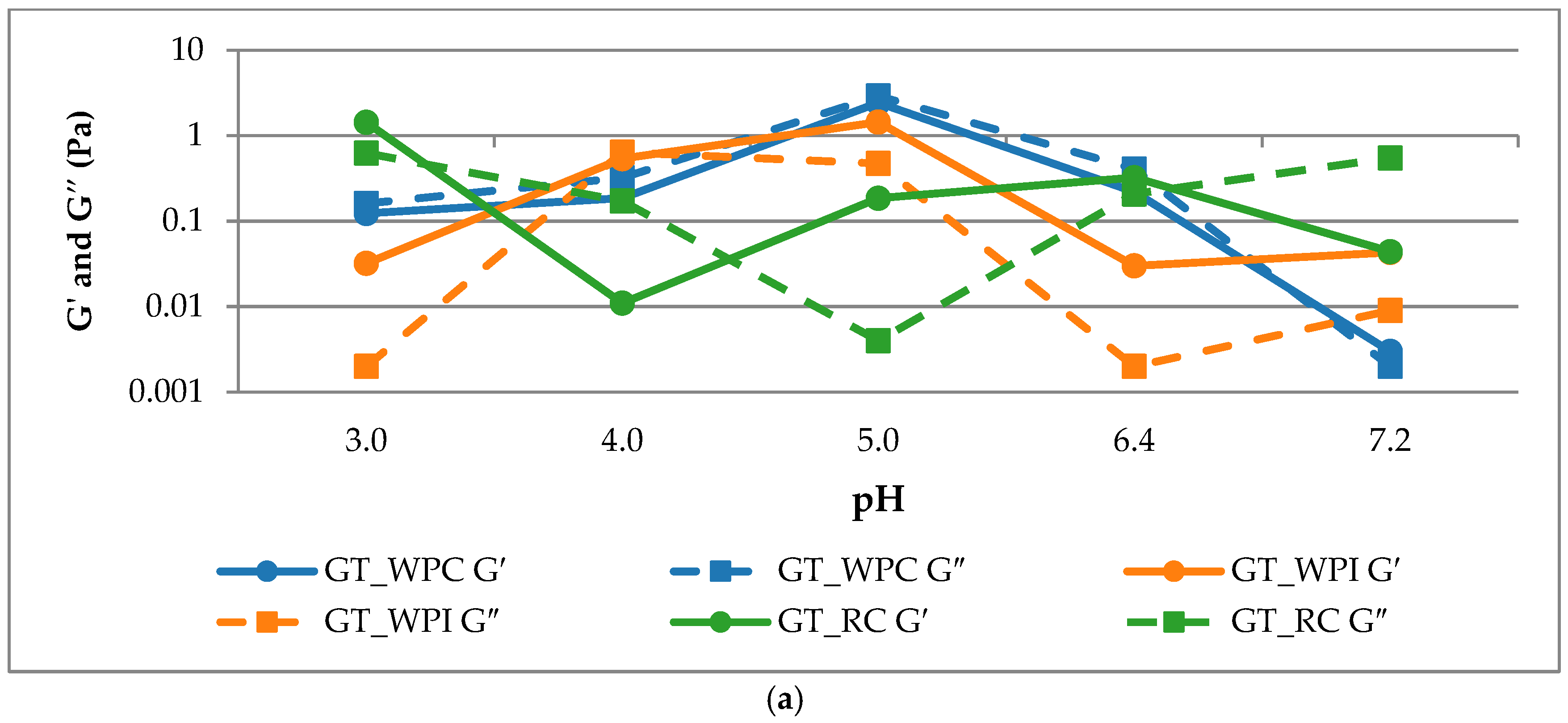

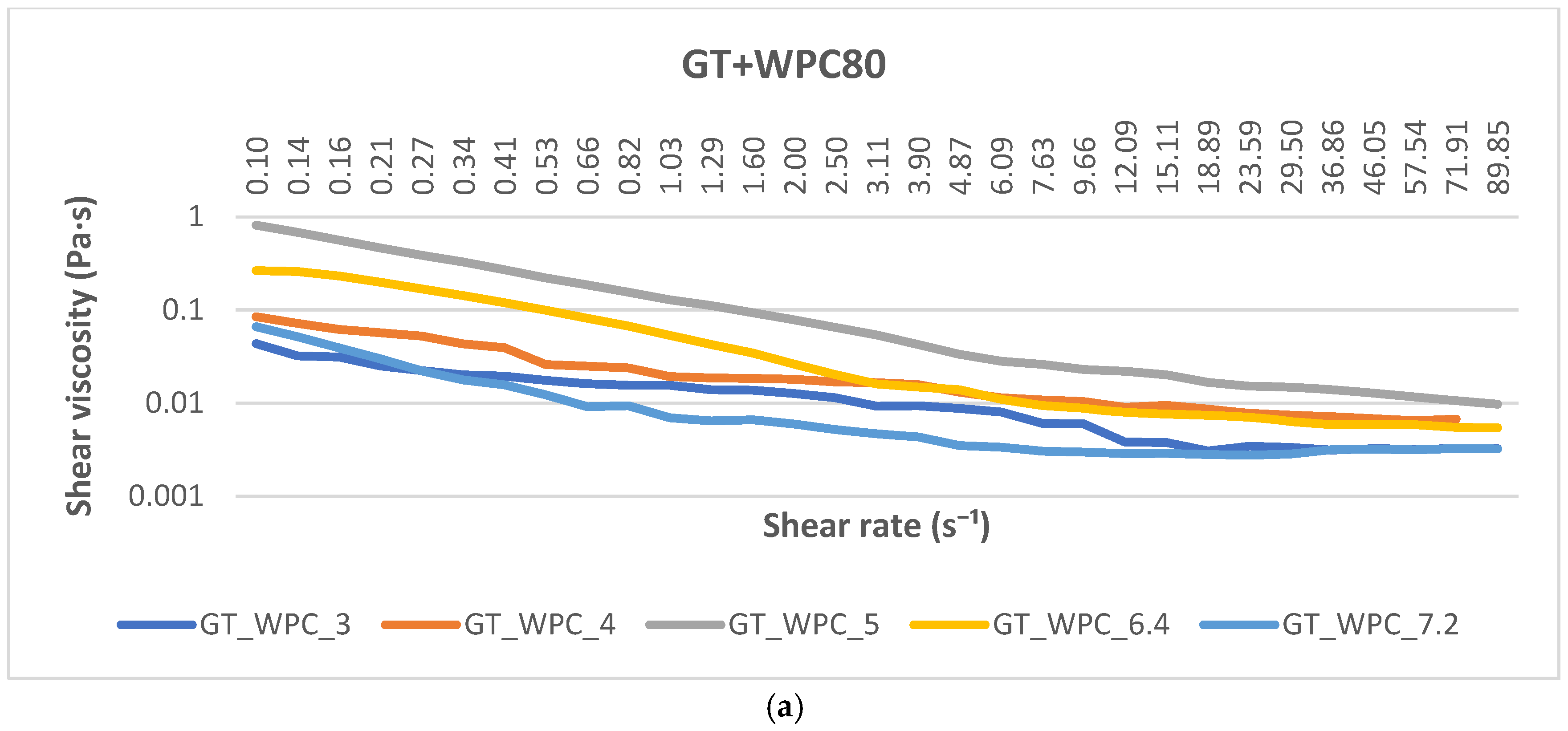
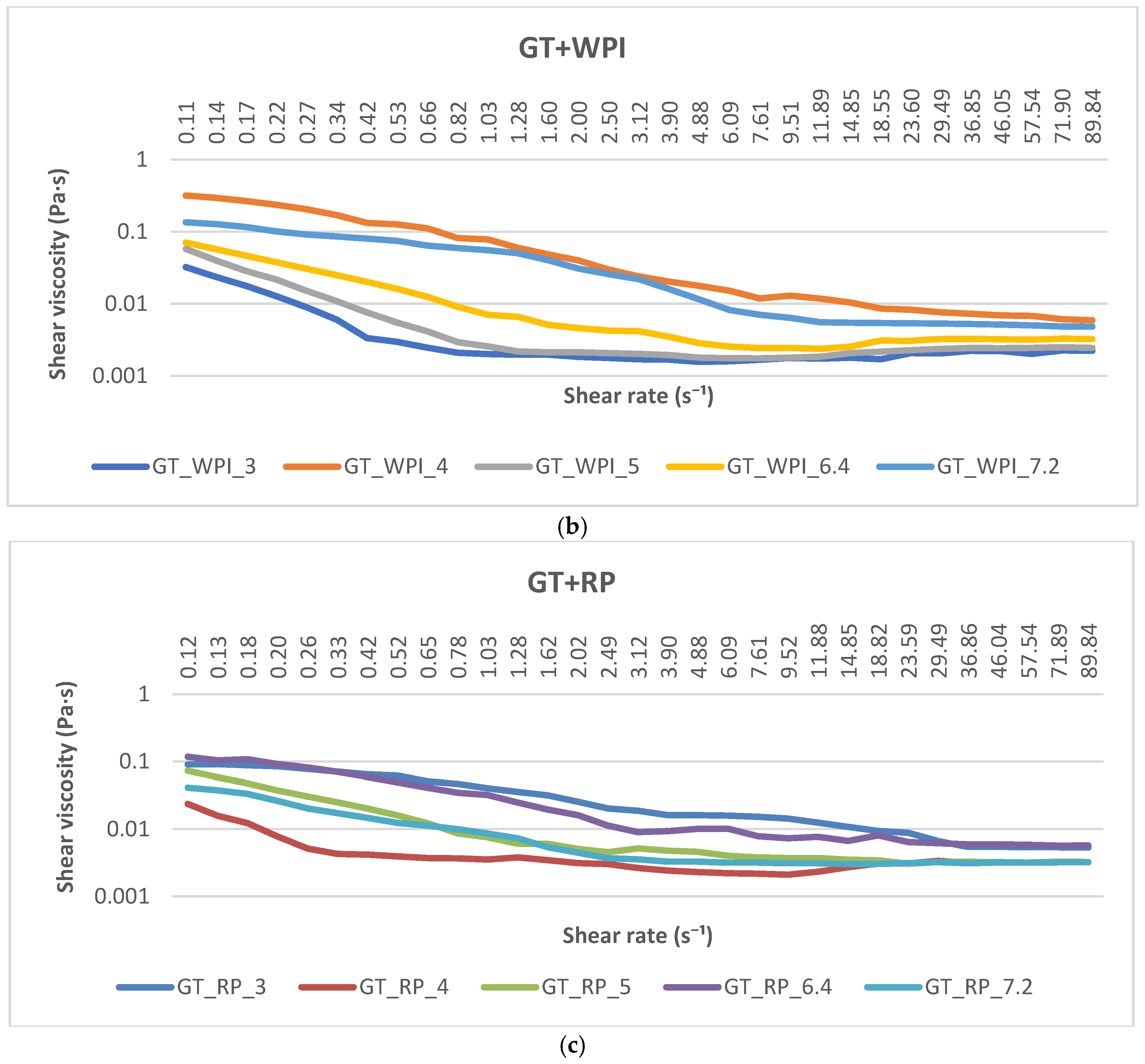
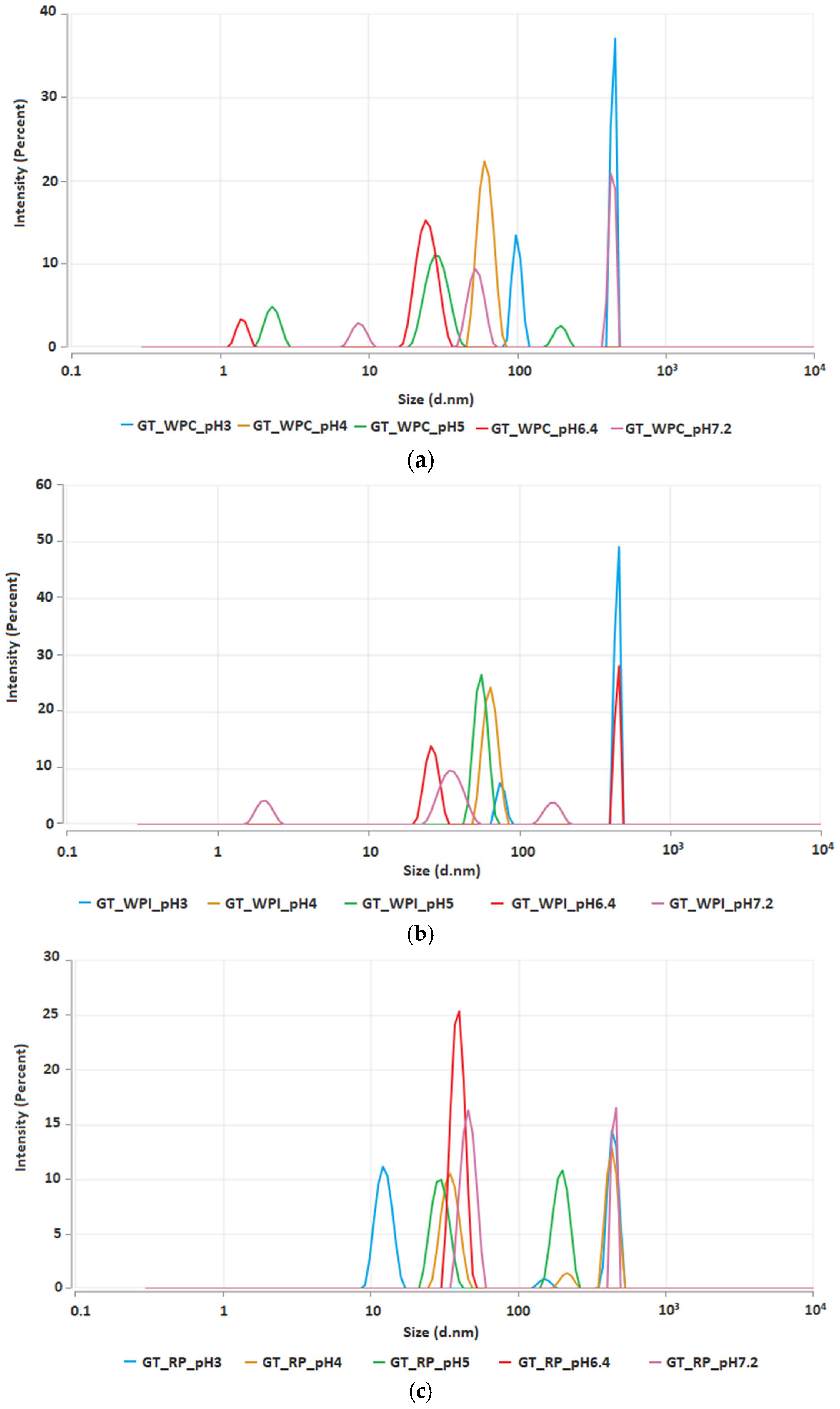
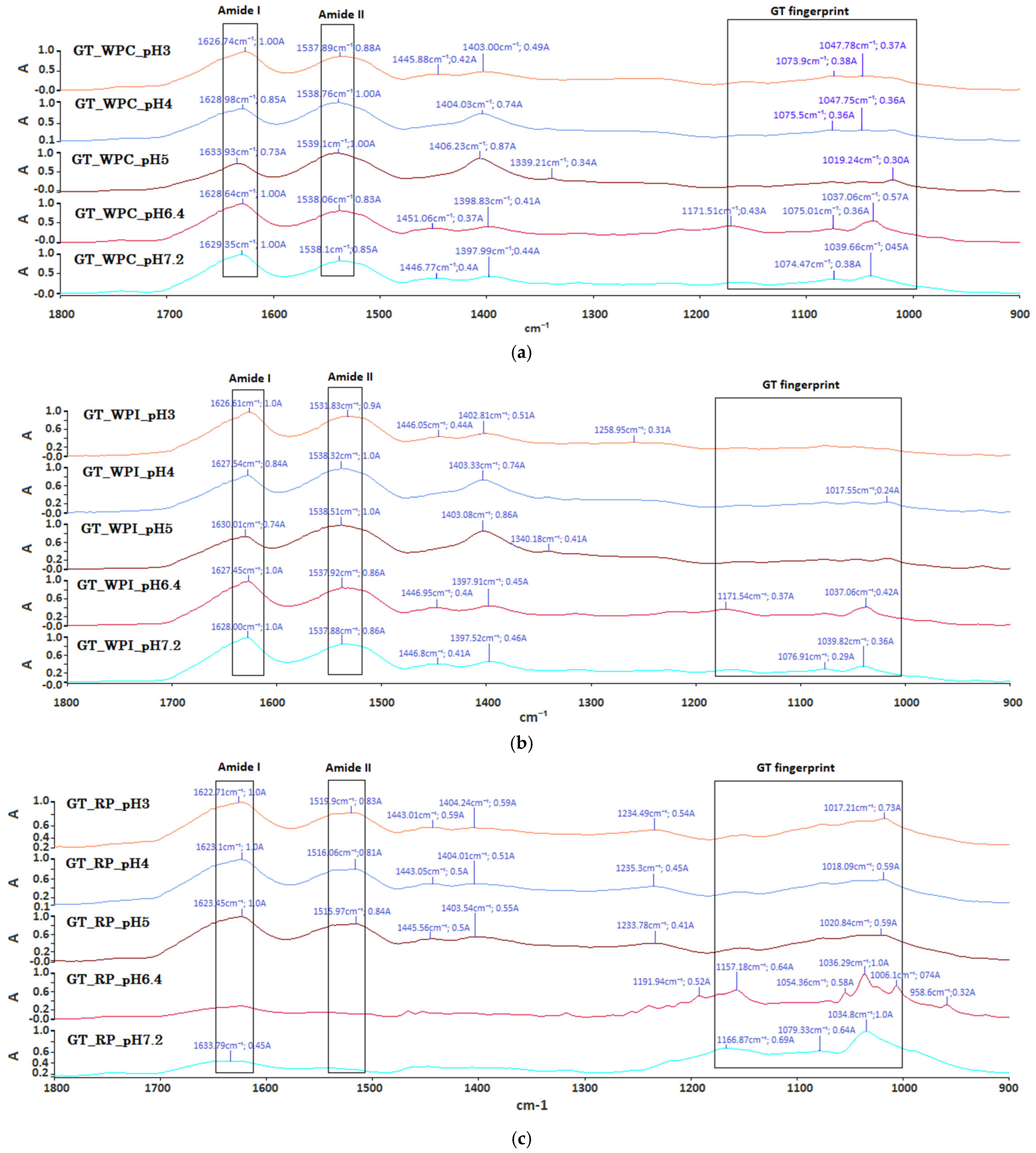


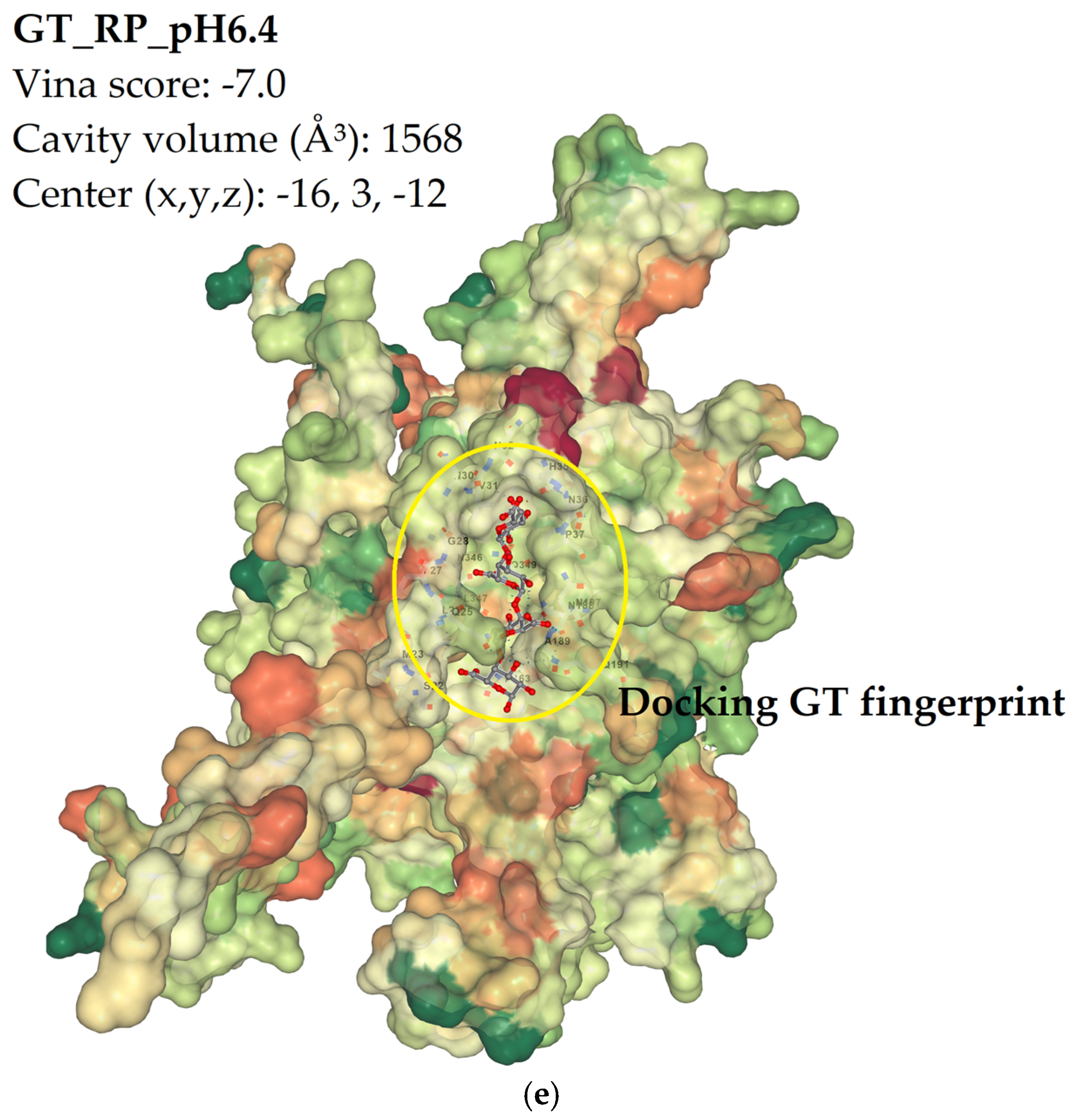
| Sample ID | Turbidity ± SD |
|---|---|
| GT_WPC_pH3 | 0.835 a ± 0.008 |
| GT_WPC_pH4 * | 2.404 f ± 0.002 |
| GT_WPC_pH5 * | 1.956 e ± 0.004 |
| GT_WPC_pH6.4 * | 1.734 d ± 0.018 |
| GT_WPC_pH7.2 | 1.492 c ± 0.003 |
| GT_WPI_pH3 | 0.728 a ± 0.006 |
| GT_WPI_pH4 * | 1.998 e ± 0.003 |
| GT_WPI_pH5 | 1.493 c ± 0.015 |
| GT_WPI_pH6.4 | 0.938 a ± 0.008 |
| GT_WPI_pH7.2 * | 2.121 e ± 0.004 |
| GT_RP_pH3 | 0.891 a ± 0.036 |
| GT_RP_pH4 * | 1.529 c ± 0.047 |
| GT_RP_pH5 | 1.392 b ± 0.005 |
| GT_RP_pH6.4 | 1.270 b ± 0.089 |
| GT_RP_pH7.2 * | 2.368 f ± 0.041 |
| Sample ID | G′ (Pa) ± SD | G″ (Pa) ± SD | δ(°) ± SD |
|---|---|---|---|
| GT_WPC_3 | 0.123 ab ± 0.021 | 0.161 a–c ± 0.033 | 52.436 e ± 3.180 |
| GT_WPC_4 | 0.185 ab ± 0.072 | 0.321 b–e ± 0.125 | 59.914 f ± 2.605 |
| GT_WPC_5 | 2.428 d ± 0.986 | 2.918 g ± 0.554 | 51.181 e ± 7.824 |
| GT_WPC_6.4 | 0.220 ab ± 0.039 | 0.407 c–f ± 0.002 | 61.869 f ± 2.345 |
| GT_WPC_7.2 | 0.003 a ± 0.002 | 0.002 a ± 0.002 | 33.691 d ± 3.958 |
| GT_WPI_3 | 0.032 a ± 0.003 | 0.002 a ± 0.0001 | 3.582 a ± 0.501 |
| GT_WPI_4 | 0.537 b ± 0.205 | 0.640 f ± 0.130 | 51.502 e ± 5.861 |
| GT_WPI_5 | 1.440 c ± 0.123 | 0.472 d–f ± 0.142 | 18.151 c ± 6.991 |
| GT_WPI_6.4 | 0.030 a ± 0.003 | 0.002 a ± 0.0002 | 3.811 a ± 0.457 |
| GT_WPI_7.2 | 0.043 a ± 0.005 | 0.009 a ± 0.004 | 11.803 b ± 3.828 |
| GT_RP_3 | 1.431 c ± 0.194 | 0.623 f ± 0.183 | 23.125 c ± 3.852 |
| GT_RP_4 | 0.011 a ± 0.007 | 0.172 a–c ± 0.029 | 86.342 g ± 4.404 |
| GT_RP_5 | 0.185 ab ± 0.173 | 0.004 a ± 0.003 | 1.400 a ± 0.894 |
| GT_RP_6.4 | 0.322 ab ± 0.013 | 0.208 a–d ± 0.009 | 32.949 d ± 0.887 |
| GT_RP_7.2 | 0.044 a ± 0.022 | 0.548 e–f ± 0.307 | 84.149 g ± 7.814 |
| Sample ID | Vina Score * | Cavity Volume (Å3) | Center (x,y,z) |
|---|---|---|---|
| GT_WPC_pH3 | −8.2 | 261 | −14, 10, 9 |
| GT_WPC_pH4 | −8.0 | 400 | −7, 13, 20 |
| GT_WPC_pH5 | −8.3 | 261 | −14, 10, 9 |
| GT_WPC_pH6.4 | −7.4 | 261 | −14, 10, 9 |
| GT_WPC_pH7.2 | −8.0 | 261 | −14, 10, 9 |
| GT_WPI_pH3 | −7.7 | 1537 | 87, 64, 42 |
| GT_WPI_pH4 | −7.2 | 1537 | 87, 64, 42 |
| GT_WPI_pH5 | −7.4 | 1250 | 49, 96, 18 |
| GT_WPI_pH6.4 | −7.3 | 1278 | 49, 96, 18 |
| GT_WPI_pH7.2 | −8.0 | 1537 | 87, 64, 42 |
| GT_RP_pH3 | −7.6 | 1050 | −1, 16, −1 |
| GT_RP_pH4 | −8.7 | 1568 | −16, 3, −12 |
| GT_RP_pH5 | −7.1 | 1568 | −16, 3, −12 |
| GT_RP_pH6.4 | −7.0 | 1568 | −16, 3, −12 |
| GT_RP_pH7.2 | −7.3 | 1512 | −16, 3, −11 |
| Sample ID | Protein | pH |
|---|---|---|
| GT_WPC_pH3 | Whey protein concentrate 80 | 3.0 |
| GT_WPC_pH4 | 4.0 | |
| GT_WPC_pH5 | 5.0 | |
| GT_WPC_pH6.4 | 6.4 | |
| GT_WPC_pH7.2 | 7.2 | |
| GT_WPI_pH3 | Whey protein isolate | 3 |
| GT_WPI_pH4 | 4 | |
| GT_WPI_pH5 | 5 | |
| GT_WPI_pH6.4 | 6.4 | |
| GT_WPI_pH7.2 | 7.2 | |
| GT_RP_pH3 | Rice protein | 3 |
| GT_RP_pH4 | 4 | |
| GT_RP_pH5 | 5 | |
| GT_RP_pH6.4 | 6.4 | |
| GT_RP_pH7.2 | 7.2 |
Disclaimer/Publisher’s Note: The statements, opinions and data contained in all publications are solely those of the individual author(s) and contributor(s) and not of MDPI and/or the editor(s). MDPI and/or the editor(s) disclaim responsibility for any injury to people or property resulting from any ideas, methods, instructions or products referred to in the content. |
© 2025 by the author. Licensee MDPI, Basel, Switzerland. This article is an open access article distributed under the terms and conditions of the Creative Commons Attribution (CC BY) license (https://creativecommons.org/licenses/by/4.0/).
Share and Cite
Szafrańska, J.O. Protein-Dependent, pH-Selective Complexation in Tragacanth–Protein Systems: An Integrated FTIR–DLS–Rheology–Docking Study. Int. J. Mol. Sci. 2025, 26, 11333. https://doi.org/10.3390/ijms262311333
Szafrańska JO. Protein-Dependent, pH-Selective Complexation in Tragacanth–Protein Systems: An Integrated FTIR–DLS–Rheology–Docking Study. International Journal of Molecular Sciences. 2025; 26(23):11333. https://doi.org/10.3390/ijms262311333
Chicago/Turabian StyleSzafrańska, Jagoda O. 2025. "Protein-Dependent, pH-Selective Complexation in Tragacanth–Protein Systems: An Integrated FTIR–DLS–Rheology–Docking Study" International Journal of Molecular Sciences 26, no. 23: 11333. https://doi.org/10.3390/ijms262311333
APA StyleSzafrańska, J. O. (2025). Protein-Dependent, pH-Selective Complexation in Tragacanth–Protein Systems: An Integrated FTIR–DLS–Rheology–Docking Study. International Journal of Molecular Sciences, 26(23), 11333. https://doi.org/10.3390/ijms262311333






